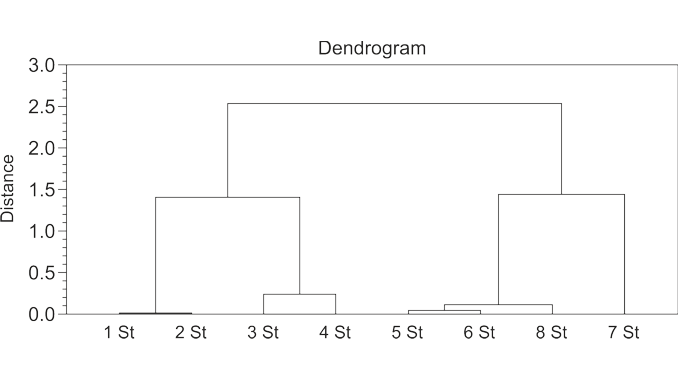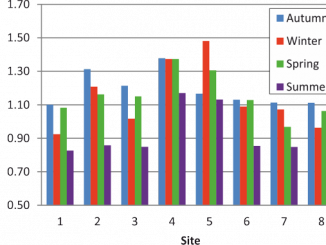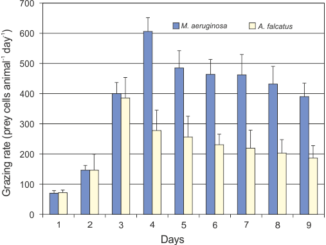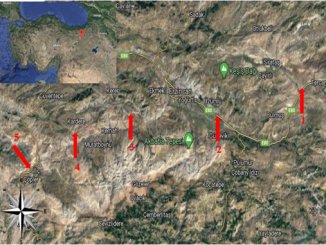
Paper category: Original research paper
Corresponding author: Banu Kutlu (kutlubanu@gmail.com)
DOI: 10.2478/oandhs-2021-0035
Received: 31/03/2021
Accepted: 23/06/2021
Full text: here
Citation (APA style): Kutlu,B.,Özcan,T. & Özcan,G.(2021).Analysis of heavy metal contamination in surface sediments of Iskenderun Bay, Turkey. Oceanological and Hydrobiological Studies,50(4) 411-420. https://doi.org/10.2478/oandhs-2021-0035
Abstract
The ecological risk resulting from the accumulation of some heavy metals in the sediments of Iskenderun Bay was assessed using the following measures: enrichment and contamination factor, pollution load index (PLI), and potential ecological risk index (RI). The concentrations of the studied heavy metals were in the following order: Fe > Ni > Mn > Cr > Zn > Cu > As > Pb > Cd > Hg. Ni and As had the highest EF values. This situation is most likely due to the presence of iron, pesticide, and fertilizer plants in the region. According to the United States Environmental Protection Agency, Ni, As, Mn, and Cr may have harmful effects on faunal communities in sediments. According to the RI, Site 4 was more contaminated and toxic than the other seven study sites, with “moderate” ecological risk. Pearson’s correlation coefficient was determined by multivariate methods – cluster and principal component analysis. As can be inferred from the RI values, the potential toxic effect of As and Ni in the sediments is moderate.
Acknowledgements
This research is supported by a Grant (Grant No. PPMUBO18-09) from The Scientific Research Projects Coordination Unit at Munzur University
References
Acevedo-Figueroa, D., Jiménez, B.D. & Rodríguez-Sierra, C.J. (2006). Trace metals in sediments of two estuarine lagoons from Puerto Rico. Environmental Pollution 141: 336–342. DOI: 10.1016/j.envpol.2005.08.037.
Adamu, C.I., Nganje, T.N. & Edet, A. (2015). Heavy metal contamination and health risk assessment associated with abandoned barite mines in Cross River State: southeastern Nigeria. Environmental Nanotechnology, Monitoring and Management 3: 10–21. DOI: 10.1016/j.enmm.2014.11.001.
Alharbi, T. & El-Sorogy, A. (2017). Assessment of metal contamination in coastal sediments of Al-Khobar area, Arabian Gulf, Saudi Arabia. Journal of African Earth Sciences 129: 458–468. DOI: 10.1016/j.jafrearsci.2017.02.007.
Anderson Abel, D.S.M, Kate, S., Werner, K., Marco, T. & Christiane, Z. (2016). Metal fate and effects in estuaries: a review and conceptual model for better understanding of toxicity. Science of The Total Environment 541: 268–281. DOI: 10.1016/j.scitotenv.2015.09.045.
Bing, H., Wu, Y., Nahm, W-H. & Liu, E. (2013). Accumulation of heavy metals in the lacustrine sediment of Longgan Lake, middle reaches of Yangtze River, China. Environmental Earth Sciences 69: 2679–2689. DOI: 10.1007/s12665-012-2090-4.
Chakravarty, M. & Patgiri, A. (2009). Metal Pollution Assessment in Sediments of the Dikrong River, N. E. India. Journal of Human Ecology 27: 63–67.
Chen, S., Chmura, G.L., Wang, Y., Yu, D., Ou, D. et al. (2019). Benthic microalgae offset the sediment carbon dioxide emission in subtropical mangrove in cold seasons. Limnology and Oceanography 64: 1297–1308. DOI: 10.1002/lno.11116.
Cubadda, F., Conti, M.E. & Campanella, L. (2001). Size-dependent concentrations of trace metals in four Mediterranean gastropods. Chemosphere 45: 561–569. DOI: 10.1016/S0045–6535 (01)00013–3.
Çevik, F., Göksu, M.Z.L., Derici, O.B. & Findik, Ö. (2009). An assessment of metal pollution in surface sediments of Seyhan dam by using enrichment factor, geoaccumulation index and statistical analyses. Environmental Monitoring and Assessment 152: 309–317. DOI: 10.1007/s10661-008-0317-3.
Datta, P.K., Ray, A.K., Sharma, V.K. & Millero, F.J. (2004). Adsorption of Arsenate and Arsenic on Titanium Dioxide Suspensions. Journal Colloid Interface Science 278(2): 270–275. DOI: 10.1016/j.jcis.2004.06.015.
Dhanakumar, S., Solaraj, G. & Mohanraj, R. (2015). Heavy metal partitioning in sediments and bioaccumulation in commercial fish species of three major reservoirs of river Cauvery delta region, India. Ecotoxicology and Environmental Safety 113: 145–151.
Dural, M. & Göksu, M.Z.L. (2006). Variations of heavy metal levels of seston benthos and sediment seasonally in Çamlik Lagoon (Karataş, Adana). Ege Journal of Fisheries and Aquatic Sciences (EgeJFAS) 23(1/1): 65–69 (In Turkish).
Duysak, Ö. & Ersoy, B. (2014). A biomonitoring study: heavy metals in Monodonta turbinata (Mollusca: Gastropoda) from Iskenderun Bay, North-Eastern Mediterranean. Pakistan Journal of Zoology 46(5): 1317–22.
Duysak, Ö., Ersoy, B. & Dural, M. (2013). Metal concentrations in different tissues o cuttlefish (Sepia officinalis) in Iskenderun Bay, Northeastern Mediterranean. Turkish Journal of Fisheries and Aquatic Sciences 13: 205–210. DOI: 10.4194/1303-2712-v13_2_02.
EPA. (1995). Summary of Guidelines For Contaminated Freshwater Sediments–1995.
Fujita, M., Yamanoi, K. & Izumiyama, H. (2014). A Combined Model of Sediment Production, Supply and Transport. Proceedings of the International Association of Hydrological Sciences 367: 357–365.
García, E.M., Cruz-Motta, J.J., Farina, O. & Bastidas, C. (2008). Anthropogenic influences on heavy metals across marine habitats in the western coast of Venezuela. Continental Shelf Research 28(20): 2757–2766. DOI: 10.1016/j.csr.2008.09.020.
Guo, W., Liu, X., Liu, Z. & Li, G. (2010). Pollution and potential ecological risk evaluation of heavy metals in the sediments around Dongjiang Harbor, Tianji. Procedia Environmental Sciences 2: 729–736.
Håkanson, L. (1980). An ecological risk index for aquatic pollution control: A sedimentological approach. Water Research 14: 975–1001. DOI: 10.1016/0043-1354(80)90143-8.
Hou, D., He, J., Lu, C., Ren, L., Fan, Q., et al. (2013). Distribution characteristics and potential ecological risk assessment of heavy metals (Cu, Pb, Zn, Cd) in water and sediments from Lake Dalinouer, China. Ecotoxicology and Environmental Safety 93: 135–144. DOI: 10. 1016/j.ecoenv.2013.03.012.
Huang, F., Xu, Y., Tan, Z., Wu, Z., Xu, H. et al. (2018). Assessment of pollutions and identification of sources of heavy metals in sediments from west coast of Shenzhen, China. Environmental Science and Pollution Research 25: 3647–3656. DOI: 10.1007/s11356-017-0362-y.
Kalay, M., Ay, Ö. & Canli, M. (1999). Heavy metal concentrations in fish tissues from the Northeast Mediterranean Sea. The Bulletin of Environmental Contamination and Toxicology 63: 673–681. DOI: 10.1007/s001289901033.
Kargın, F., Coğun, H.Y., Yüzereroğlu, T.A., Fırat, Ö. & Gök, G. (2006). Metal Concentrations in fish species from the northeast Mediterranean Sea. Environmental Monitoring and Assessment 121: 431–438.
Lollar, B. (2005). Environmental Geochemistry. First Edition. Amesterdam: Elsevier Science.
Long, E.R., Ingersoll, C.G. & MacDonald, D.D. (2006). Calculation and uses of mean sediment quality guideline quotients: A critical review. Environmental Science and Technology 40: 1726–1736. DOI: 10.1021/es058012d.
Machado, W., Sanders, C.J., Santos, I.R., Sanders, L.M., SilvaFilho, E.V. et al. (2016). Mercury dilution by autochthonous organic matter in a fertilized mangrove wetland. Environmental Pollution 213: 30–35. DOI: 10.1016/j.envpol.2016.02.002.
Mohiuddin, K.M., Zakir, H.M., Otomo, K., Sharmin, S. & Shikazono, N. (2010). Geochemical distribution of trace metal pollutants in water and sediments of downstream of an urban river. International Journal of Environmental Science and Technology 7(1): 17–28. DOI: 10.1007/BF03326113.
Olgunoğlu, M.P.P. & Polat, S. (2007). Seasonal changes of heavy metals in two macroalgae species [Cystoseira corniculata (Phaeophyta), Laurencia papillosa (Rhodophyta)] in the Iskenderun Bay. Ege Journal of Fisheries and Aquatic Sciences (EgeJFAS) 24(1–2): 25–30 (In Turkish).
Özcan, T., Katağan, T. & Peter, K.N.L. (2010). First record of Eurycarcinus integrifrons De Man 1879 (Decapoda, Pilumnidae) from the Mediterranean Sea. Crustaceana 83(4): 507–510.
Skordas, K., Kelepertzis, E. & Kosmidis, D. (2015). Assessment of nutrients and heavy metals in the surface sediments of the artificially lake water reservoir Karla, Thessaly, Greece. Environmental Earth Sciences 73: 4483–4493. DOI: 10.1007/s12665-014-3736-1.
Suresh, G., Ramasamy, V., Meenakshisundaram, V., Venkatachalapathy, R. & Ponnusamy, V. (2011). Influence of mineralogical and heavy metal composition on natural radionuclide concentrations in the river sediments. Applied Radiation and Isotopes 69(10): 1466–1474. DOI: 10.1016/j.apradiso.2011.05.020.
Sutherland, R. (2000). Bed sediment-associated trace metals in an urban stream, Oahu, Hawaii. Environmental Geology 39(6): 611–627.
Türkmen, A. & Aras, S. (2011). Investigation of heavy metal accumulation in sea water and sediment in İskenderun Bay. Journal of Black Sea Science 1–23.
Vrhovnik, P., Šmuc, N.R., Dolenec, T., Serafimovski, T. & Dolenec, M. (2013). An evaluation of trace metal distribution and environmental risk in sediments from the Lake Kalimanci (FYR Macedonia). Environmental Earth Sciences 70(2): 761–775. DOI: 10.1007/s12665-012-2166-1.
Wei, B.G. & Yang, L.S. (2010). A review of heavy metal contaminations in urban soils, urban road dusts and agricultural soils from China. Microchemical Journal 94(2): 99–107. DOI: 10.1016/j.microc.2009.09.014.
Yalcin, M.G., Coskun, B., Nyamsari, D.G. & Yalcin, F. (2019). Geomedical, ecological risk, and statistical assessment of hazardous elements in shore sediments of the Iskenderun Gulf, Eastern Mediterranean, Turkey. Environmental Earth Sciences 78: 438. DOI: 10.1007/s12665-019-8435-5.
Yang, Q., Lei, A.P., Li, F.L., Liu, L.N., Zan, Q.J. et al. (2014). Structure and function of soil microbial community in artificially planted Sonneratia apetala and S. caseolaris forests at different stand ages in Shenzhen Bay, China. Marine Pollution Bulletin 85: 754–763.



